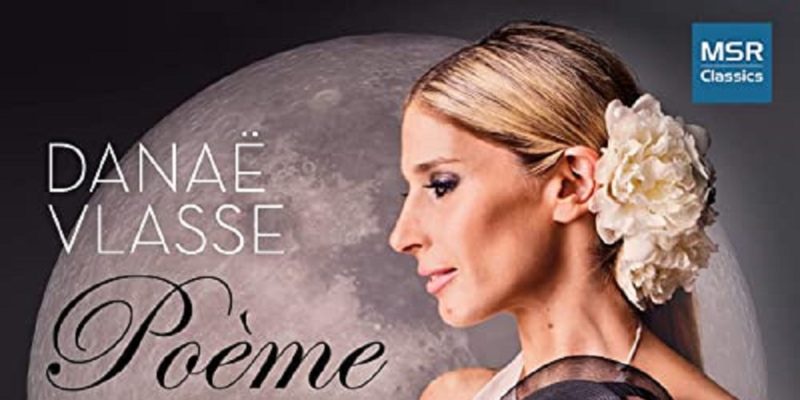Welcome to 9 songs about ‘life, love and loss’ for soprano and piano.
This collection is the brainchild of pianist, composer, lyricist and producer, Danaë Xanthe Vlasse. So it’s safe to say that she has absolutely poured herself into the project.
Within classical circles, this collection may attract the kind of forensic analysis that relies upon the detail of metrics, compositional sophistication, level of virtuosity… I’m going to focus on the intention of the collection – and more importantly on the level to which it engages, transports and delights the listener.
The first and most obvious thing to say is that we are dealing with a very limited set of colours here, so the album needs to provide breadth in order to keep the listener engaged. It’s voice and piano. Which is fine, of course, just ask Adele: Someone Like You seemed to do OK. Oh, and there’s also a ‘cello on the final track, Sérénade De Verlaine.
Each composition has been inspired by a piece of poetry – from well-known poets (some of which Vlasse has translated into English) and some written by Vlasse herself – in both original French and her own English translation, which was very helpful for me. But it doesn’t simply feel like an exploration or reaction to pieces of literature, as there is a body of supporting work to accompany the album. Artworks by the likes of Klimt and Van Gogh are added to the website as visual stimuli, and there are full-on accompanying videos available for some of the tracks, too.
For instance, Piano Fantaisie #2 – Swansong is not simply beautifully played (which it is). Vlasse provides a video and the poem that inspired the piece. Listening to it with these accompaniments feels like a multi-level experience that gathers you up and takes you on a sensory journey.
The music begins in a quite stately and measured way; lyrical runs up and down the keys on one hand and gentle arpeggios on the other. It then features disparate rhythms played by each hand, which come together in runs and trills that suggest cinematic action! You can absolutely envisage balletic scenes from Swan Lake /Black Swan or a David Attenborough documentary with this music syncopating with swans’ behaviour, particularly at about 2 minutes, when two adult swans are clearly competing for something…
Sorry, I got a bit carried away there. I guess what I’m saying is the album leans into something akin to a multi-sensory experience… intellect, emotion, poetry, visual story-telling, painting with sounds… if you choose, all are engaged by this melting pot that Vlasse has put together.
The pieces vary greatly – from the more-sparse 2 minute opener Le Baiser (that could be from a Kate Bush project, were she to undertake soprano duties) to the suitably epic La Mer that weighs in at the best part of a quarter hour… The latter track does what you’d hope, too – see-sawing rhythms, swells of melody that bend upward to indicate peril, relentlessly shifting, with lulls and changes of direction in both rhythm and melody. There are also hints of influences amongst it all – I spotted some Satie-esque voicings in the piano chords… And of course, the sea rises up powerfully at certain moments, to break on the shore and the ship…
Some stark beauty and despair, inspired by writings on World War II by Jacques Prévert, is explored on the quietly elegiac Barbara. Mostly downbeat and sometimes on a monotone to underline its solemnity, it’s darkly mournful and beautiful, with a tasteful, highly restrained conclusion.
These differences between the tracks all keep keep things fresh and moving.
But this is music and so much more than an intellectual exercise, which is what I might be starting to make it sound like…
It goes without saying (but I’m going to say it anyway) that the execution of the tracks is carried out at an exceptionally high level.
Vlasse shares piano duties with Robert Thies, and the non-instrumental tracks feature the sopranos Hila Plittman and Sangeeta Kaur. Both get the chance to harmonise with themselves, and I personally find it’s always thrilling to hear a soprano’s vibrato lock into itself in a perfect unison.
On the final track Sérénade De Verlaine, Kaur’s soprano enjoys the added dynamic of ‘cello (John Walz), and this adds a nice new flavour to round off the collection.
Of course, one can just listen to this near-hour long collection, accepting it on face value – close one’s eyes and be transported. But go deeper, and there’s the care and the inspirations (and the media) behind the pieces to enjoy, and they may augment your experience further… That was certainly the case for me.
Grab the album via Amazon.


Dear Chris, Thank you so much for this thoughtful and inspired review! I’m honored to have had your time and passionate attention on my work! 🙂
Hi Danaë – it was my pleasure – congratulations on the project 🙂